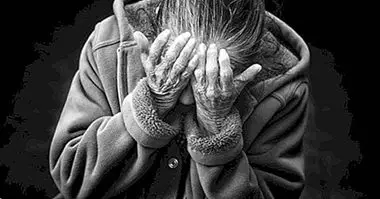The 5 differences between Anorexia and Bulimia
In today's society, great importance is attached to the physical aspect. From the media to the most private forms of interaction, few areas of life allow us to move away from the general conception that equates thinness and physical attractiveness with perfection and success.
Anorexia and bulimia are two eating disorders in whose development the social pressure to reach an ideal physique plays a fundamental role. The closeness between these two diagnoses sometimes causes some confusion regarding its definition.
- Related article: "Main eating disorders: anorexia and bulimia"
Defining anorexia and bulimia
Anorexia nervosa is characterized by the restriction voluntary consumption of food and the progressive thinning to the bottom. Likewise, there is a distortion of the body image; This means that people with anorexia look thicker than they are.
Anorexia has two subtypes: the restrictive one, in which weight is lost mainly through fasting and physical exercise, and the compulsive / purgative, in which binges and purges occur.
On the other hand, in bulimia the emotional discomfort or stress trigger binge eating , in general of foods with a high caloric content, followed by purgative behaviors (vomit, use laxatives) or compensatory (fasting, intense exercise) that are the result of feelings of guilt or shame. During binge eating you experience a feeling of loss of control over your intake.
Bulimia is also classified according to two types, one purgative and one nonpurgative, which corresponds more to compensatory behaviors such as fasting.
Other psychological problems with a similar profile they are orthorexia nervosa, which is characterized by the obsession to eat only healthy food, body dysmorphic disorder, consisting of excessive concern for some physical defect, and vigorexia or muscle dysmorphia, a subtype of the former.
- Related article: "The 10 most common eating disorders"
5 differences between anorexia and bulimia
Even keeping in mind that the diagnoses are only orientative tools and that the symptoms of anorexia and bulimia can overlap, it is convenient to review the main differences between these two disorders as they are understood by the Psychology textbooks.
1. The main symptoms: restriction or binge eating
The behavioral symptoms are one of the fundamental differences between bulimia and anorexia. In general, in anorexia there is a strict control over behavior while bulimia has a more compulsive and emotional component.
In the case of bulimia the presence of frequent bingeing is necessary for diagnosis. Although in anorexia these episodes can also occur, they are basic only in the compulsive / purgative subtype, and tend to be much less intense than in bulimia.
Purgative and compensatory behaviors can occur in both disorders. However, in the case of bulimia there will always be one or both, since the person feels the need to lose the weight gained through binge eating, while in anorexia these behaviors may be unnecessary if the caloric restriction is sufficient as to meet the goals of weight loss.
Binge eating disorder is another diagnostic entity that is characterized exclusively by recurrent episodes of uncontrolled ingestion. Unlike those that occur in bulimia and anorexia, in this case binge eating is not followed by purgative or compensatory behavior.
- Related article: "Psychology and Nutrition: the link between emotion and food"
2. Weight loss: underweight or fluctuating weight
The diagnosis of anorexia nervosa requires a persistent urge to lose weight and that is significantly below the minimum weight that it should have based on its biology. This is usually measured by the Body Mass Index or BMI, which is calculated by dividing the weight (in kilos) by height (in meters) squared.
In anorexia, BMI tends to be below 17.5, which is considered to be underweight, while the normal range is between 18.5 and 25. People with a BMI of more than 30 are considered obese. to take into account, in any case, that the BMI is an indicative measure that does not differentiate between muscle mass and fat tissue and that is especially imprecise in very high or very low people.
In bulimia the weight is usually within the range considered healthy . However, there are important fluctuations, so that in periods when binge eating predominates the person can gain a lot, and when the restriction is maintained for a long time, the opposite may occur.
3. The psychological profile: obsessive or impulsive
The anorexia tends to relate to control and order , whereas bulimia is associated more with impulsivity and emotionality.
While this is only general trends, if we wanted to make a psychological profile of a person "stereotypically anorexic" we could qualify as introverted, socially isolated, with low self-esteem, perfectionist and self-demanding. Opposite, bulimic people they are usually more emotionally unstable , depressed and impulsive, and more prone to addictions.
It is interesting to relate these diagnoses to the personality disorders that are most commonly associated with each of them. While obsessive-compulsive and avoidant personalities predominate in anorexia, in bulimia there are usually cases of histrionic and borderline disorder.
Additionally, in anorexia there is more frequent denial of the problem, which is more easily assumed in people with bulimia.
- Related article: "The 10 types of Personality Disorders"
4. The physical consequences: serious or moderate
The physical alterations derived from anorexia are more severe than those caused by bulimia since the former can lead to death by starvation. In fact, in many cases of anorexia hospitalization is resorted to so that the person recovers an acceptable weight, while in bulimia this is significantly less frequent.
In anorexia it is much more common to occur amenorrhea, that is, the disappearance of menstruation or its non-appearance in cases that start at a very young age. It is also usually detected skin dryness, hair weakness and appearance of lanugo (a very fine hair, like that of newborns), hypotension, cold sensation, dehydration and even osteoporosis. The majority of symptoms are attributable to starvation.
Some common physical consequences in bulimia are swelling of the parotid gland and face, reduction of potassium levels (hypokalemia) and the appearance of dental caries due to the dissolution of enamel caused by recurrent vomiting. Vomiting can also cause the so-called "Russell sign" , calluses in the hand due to friction with the teeth.
These physical alterations depend more on the specific behaviors of each person than on the disorder itself. Thus, while vomiting may be more frequent in bulimia, an anorexic who vomits recurrently will also damage your tooth enamel.
5. The age of onset: adolescence or youth
Although these eating disorders can occur at any age, the most common is that each of them begins in a certain period of life.
The bulimia it typically starts in youth , between 18 and 25 years old. Since bulimia is related to psychosocial stress, its frequency of appearance increases at about the same age when responsibilities and the need for independence gain strength.
On the other hand, anorexia tends to start at younger ages , mainly in adolescence, between 14 and 18 years. In general, the development of anorexia has been associated with the social pressures derived from sexual maturation and the adoption of gender roles, in particular women, since for men the demand for thinness is usually lower.
- Related article: "Anorexia and bulimia could have a genetic origin"
"Bulimia" and "anorexia" are just labels
Although in this article we have tried to clarify what are the fundamental differences between the diagnosis of bulimia and anorexia, the truth is that both behavior patterns are close in many ways. As we have seen, many of the characteristic behaviors of these two disorders, such as recurrent vomiting or the practice of intense exercise, are as characteristic of one as the other and in some cases only their frequency or centrality in the problem allow us to differentiate between anorexia and bulimia.
Further, it is quite frequent that both diagnoses overlap , either successively or alternately. For example, a case of anorexia in which binge-eating occurs from time to time could eventually lead to bulimia. In addition, if the same person recovered their previous patterns, it would fit again with the diagnosis of anorexia. In general, if the conditions for the diagnosis of anorexia are met, priority is given over bulimia.
This makes us reflect on the rigidity with which we generally conceptualize disorders, whose names do not cease to be labels with the function of helping clinicians to have a general vision about the most recommendable intervention tools at the time of facing each one of their cases.
Bibliographic references:
- American Psychiatric Association. (2013). Diagnostic and statistical manual of mental disorders (5th ed.). Washington, DC: Author.
- Fernández-Aranda, F. and Turón, V. (1998). Eating disorders: Basic treatment guide in anorexia and bulimia. Barcelona: Masson.



















